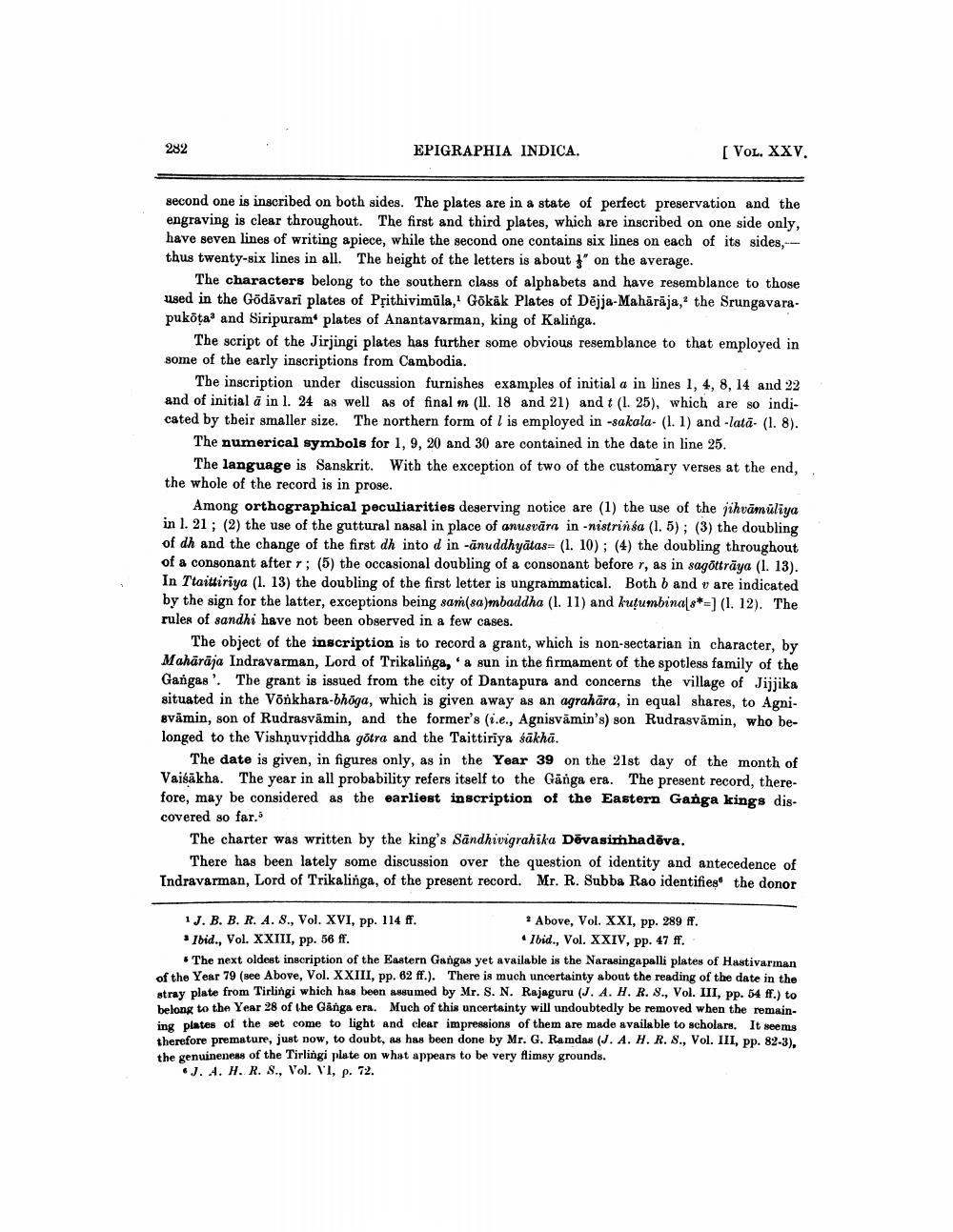________________
282
EPIGRAPHIA INDICA.
[ Vol. XXV.
second one is inscribed on both sides. The plates are in a state of perfect preservation and the engraving is clear throughout. The first and third plates, which are inscribed on one side only, have seven lines of writing apiece, while the second one contains six lines on each of its sides --- thus twenty-six lines in all. The height of the letters is about t' on the average.
The characters belong to the southern class of alphabets and have resemblance to those used in the Godavari plates of Prithivimüla, Gökāk Plates of Dējja-Mahārāja, the Srungavarapukota. and Siripuram plates of Anantavarman, king of Kalinga.
The script of the Jirjingi plates has further some obvious resemblance to that employed in some of the early inscriptions from Cambodia.
The inscription under discussion furnishes examples of initial a in lines 1, 4, 8, 14 and 22 and of initial à in l. 24 as well as of final m (11. 18 and 21) and t (1. 25), which are so indicated by their smaller size. The northern form of l is employed in -sakala- (1.1) and -latā. (1. 8).
The numerical symbols for 1, 9, 20 and 30 are contained in the date in line 25.
The language is Sanskrit. With the exception of two of the customary verses at the end, the whole of the record is in prose.
Among orthographical peculiarities deserving notice are (1) the use of the jihvāmuliya in l. 21; (2) the use of the guttural nasal in place of anusvāra in-nistrinsa (1.5); (3) the doubling of dh and the change of the first dh into d in -anuddhyātas. (1. 10) : (4) the doubling throughout of a consonant after r; (5) the occasional doubling of a consonant before r, as in sagöttrāya (1. 13). In Ttaittiriya (1. 13) the doubling of the first letter is ungrammatical. Both b and v are indicated by the sign for the latter, exceptions being sam(sa)mbaddha (1. 11) and kuțumbina[8*=] (1. 12). The rules of sandhi have not been observed in a few cases.
The object of the inscription is to record a grant, which is non-sectarian in character, by Mahārāja Indravarman, Lord of Trikalinga, 'a sun in the firmament of the spotless family of the Gangas'. The grant is issued from the city of Dantapura and concerns the village of Jijjika situated in the Võrkhara-bhöga, which is given away as an agrahāra, in equal shares, to Agnievāmin, son of Rudrasvāmin, and the former's (i.e., Agnisvāmin's) son Rudrasvāmin, who belonged to the Vishņuvsiddha götra and the Taittiriya sākha.
The date is given, in figures only, as in the Year 39 on the 21st day of the month of Vaisakha. The year in all probability refers itself to the Gänga era. The present record, therefore, may be considered as the earliest inscription of the Eastern Ganga kings discovered so far.
The charter was written by the king's Sandhivigrahika Dövasimhadēva.
There has been lately some discussion over the question of identity and antecedence of Indravarman, Lord of Trikalinga, of the present record. Mr. R. Subba Rao identifies the donor
1 J. B. B. R. A. 8., Vol. XVI, pp. 114 ff.
* Above, Vol. XXI, pp. 289 ff. Ibid., Vol. XXIII, pp. 56 ff.
• Ibid., Vol. XXIV, pp. 47 ff. • The next oldest inscription of the Eastern Gangas yet available is the Narasinga palli plates of Hastivarman of the Year 79 (see Above, Vol. XXIII, pp. 62 ff.). There is much uncertainty about the reading of the date in the stray plate from Tirlingi which has been assumed by Mr. S. N. Rajaguru (J. A. H. R. 8., Vol. III, pp. 54 ff.) to belong to the Year 28 of the Ganga era. Much of this uncertainty will undoubtedly be removed when the remaining plates of the set come to light and clear impressions of them are made available to scholars. It seems therefore premature, just now, to doubt, as has been done by Mr. G. Ramdas (J. 4. H. R. 8., Vol. III, pp. 82-3). the genuineness of the Tirlingi plate on what appears to be very flimsy grounds.
J. 4. H. R. S., Vol. VI, p. 72.




